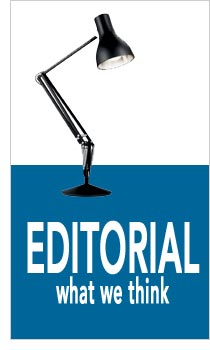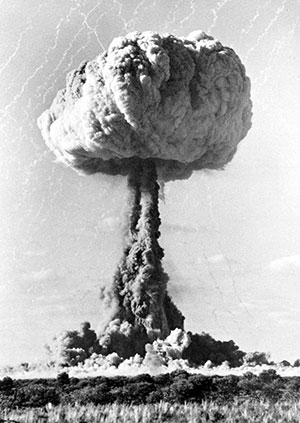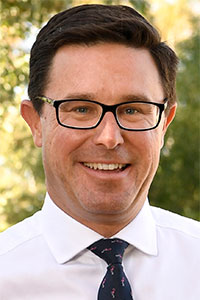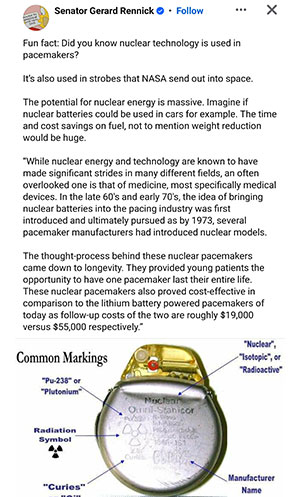
May 22, 2024
by Anne Miller
From 1952 to 1963, the British Government – with the consent of the Liberal-Country Party in Australia – conducted open air atomic bomb tests at Maralinga in South Australia, and on the Montebello Islands off WA.
It was the height of the Cold War and Western governments – led by the USA – were finding Communists under every bed.
The hysteria was real, hence the push for MAD, ie. Mutually Assured Destruction, the theory the Soviets would not fire nuclear weapons if the USA and its Allies could get theirs off the ground first.
The Brits, a key part of NATO, would never think of testing a nuclear weapon in Wales, Scotland or Jersey. But Australia – its former colony of just half a century or so earlier – seemed perfect.
(The fact the lands chosen were home to Indigenous Australians didn’t factor into the minds of the UK or Australian politicians. After all, it was pre-1967, and the Australian Government didn’t even bother counting our First Nations residents in the Census).
According to the National Museum, Britain conducted 12 major trials of nuclear devices in Australia.
Some resulted in mushroom clouds reaching heights of 14,325 metres, and radioactive fallout blown by wind was detected as far away as Townsville.
As well, Britain conducted about 200 minor trials between 1953-63 aimed at testing the performance of weapons components and investigating safety issues, according to the Museum’s website.
The fact the land would be contaminated for thousands and thousands of years didn’t seem to bother anyone, but was well known in the halls of the UK Parliament.

In fact, an expose by investigative reporter Frank Walker years later revealed how secret monitoring stations were set up around Australia to measure radiation levels from the fallout.
And alarmingly, many people who died in Australian hospitals for decades later – including babies – had samples taken secretly from their bones so strontium levels could be measured by British scientists.
I was born in 1959. As a child in primary school in NSW I can remember being forced to drink the free milk given by the government. It was always warm and sickly, and left me with a dislike of milk for the rest of my life.
What I didn’t know then – but learned about 20 years later – was experiments on dairy cattle at the time showed that radioactive Iodine-131, and possibly Strontium-90, had entered the food chain and thus into the milk that was being force-fed to Australian schoolchildren.
What does it feel like to be a lab rat? When I see so many people in my age group coming down with cancer, I can’t help but wonder how those early doses of radioactive material may have added to Australia’s disease burden now.
So fast forward to the 1970s, and I was signing petitions to stop atmospheric French nuclear tests at Mururoa Atoll.
Then in 1985, French agents sank the Rainbow Warrior and the whole world started to wake up to the risk of nuclear tests, either open air or underground.
* * *
That brings me to now – and the Federal Coalition’s determined push to introduce nuclear energy into Australia.
I know there’s a big difference between nuclear weapons testing and nuclear power production, but I’m also sufficiently suspicious not to take any politicians’ word at face value about nuclear safety.
Once bitten, you might say …
Most of our readers would remember Three Mile Island (1979), Chernobyl (1986) and Fukushima (2011) but how many know about all the other nuclear accidents – ranging from small to potentially catastrophic – at nuclear power stations in Belgium, Canada, France, East Germany and India as well as Japan and the US?
In fact, Wikipedia currently lists more than 100 incidents from 1952 to 2009.

My local MP, David Littleproud – born in 1976, years after Maralinga – seems to be a big fan of nuclear energy.
He’s also a big fan of Small Modular Reactors (SMRs) but, unfortunately for Mr Littleproud, they don’t seem to exist in commercial form at present.
According to the International Atomic Energy Agency (IAEA):
“Both public and private institutions are actively participating in efforts to bring SMR technology to fruition within this decade. Russia’s Akademik Lomonosov, the world’s first floating nuclear power plant that began commercial operation in May 2020, is producing energy from two 35 MW(e) SMRs. Other SMRs are under construction or in the licensing stage in Argentina, Canada, China, Russia, South Korea and the United States of America.”
So, even if Australia wanted to, we could not buy an SMR “off the shelf” and install it at, say, Tarong at any time soon.
As well, Mr Littleproud has said he would be willing to live near a nuclear plant, citing Lucas Heights, south of Sydney, as an example.
I would suggest Mr Littleproud take a look at a map, where he will see the small research reactor at Lucas Heights – used to manufacture medical isotopes – is surrounded by bushland.
And the nearby suburb of Lucas Heights was renamed Bardon Ridge in 1992 to remove the nuclear stigma, which suggests at least some people did not want to be reminded there was a nuclear reactor, even a tiny one, just over the ridgeline.
The OPAL reactor at Lucas Heights, currently shut down for maintenance, is a 20MW research reactor which does not produce electricity. It uses just 37kg of uranium – hardly of major benefit to the Australian mining industry.
In comparison, the coal-fired Tarong Power Stations produce a total of about 1840MW of electricity.
The IAEA says an SMR would have a power capacity of up to 300MW per unit. So potentially we would require about six to replace Tarong …
Traditional nuclear power generating plants, which have now been added to the Coalition discussion, can pump out much more; more than 7000MW in some instances in Japan and South Korea.
However, the amount of water and uranium required for these larger plants is obviously much larger than the burden on the environment posed by Lucas Heights.
Putting aside the risks of accidents at the actual reactor (which are real, despite what the fans say), there is the not-so-small matter of nuclear waste which would be created by nuclear power generation (whether using big or small reactors).
Ironically, Mr Littleproud’s preferred SMRs could actually create more nuclear waste than larger, conventional nuclear power plants (see this latest Stanford University research)

One of the most puzzling factors to me about the current “nuclear debate” is that the people who scream the loudest on social media that they “don’t consent” to vaccinations or believe the government is controlling the weather or disease outbreaks by “chemtrails”, also seem to believe nuclear energy is “safe”.
They believe Conservative politicians when they say nuclear is the “green” option as opposed to powerlines, which already criss-cross the country.
But how can nuclear be green? Its dangerous waste lasts tens of thousands of years, and there is a lot of it.
According to Stanford, spent nuclear fuel in the US is currently stored at reactor sites, accumulating at a rate of about 2000 metric tonnes a year!
If we’re not content to store this dangerous waste on site (Meandu Mine anyone?) it would have to be trucked or railed to somewhere “safe” and buried (my guess, would be on Aboriginal land somewhere – maybe even at Maralinga).
To get it there, it would have to pass through many country towns and farming localities.
We never have semi-trailer crashes do we? Or level-crossing smashes? Trucks never spill their loads, rail wagons never derail …
I’m sorry, Mr Littleproud, nuclear waste does not sound “green” or “safe”.
And nuclear energy is very, very expensive as the CSIRO pointed out this week.
Australians were lied to by politicians in the 1960s about the safety of nuclear tests on our soil.
We must be wary of politicians lying to us now about the pitfalls of renewable energy and the “safety” of nuclear power.
I fear there are some very strong voices on the sidelines calling the shots in this “debate”, and they are not people we have elected.
External links:
Related articles:
- Nuclear Too Expensive: CSIRO
- Nuclear Sites Still Under Wraps
- Nuclear? No Worries, Says MP
- MP Supports Local Nuke Discussion
- Rally Against ‘Reckless Renewables’
- MP Calls For Renewables ‘Pause’
- Nats Target ‘Reckless Renewables’
- Replace Coal With Nuclear: MP
- Read more Editorial columns
























Congratulations to SB Online for the excellent article on nuclear power. Three cheers, it had to be said even if the brickbats start flying. You certainly have my support.
I have said for ages “think nuclear, think Chernobyl in the Ukraine, Fukushima in Japan, Three Mile Island in the USA” to demonstrate nuclear accidents do happen with devastating outcomes. Revisit the old movie “Silkwood”.
As for cover-ups and the powers-that-be … in my role as a country GP back in the 1970s, I treated a Vietnam vet who had been drenched with Agent Orange. On my inquiries, I was told not to go there, and rural doctors like me should not ask such questions!
Food for thought, Anne. I really hope a lot of people take note and start thinking
I am really baffled by how many fellow Lefties are pro-nuclear these days.
Congrats on a well-researched, thoughtful article.